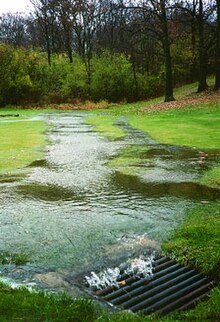Limpasan permukaan

Limpasan permukaan adalah aliran air yang mengalir di atas permukaan karena penuhnya kapasitas infiltrasi tanah. Limpasan merupakan unsur penting dalam siklus air dan salah satu penyebab erosi.[1][2]
Limpasan yang muncul di permukaan sebelum mencapai saluran disebut sumber tidak langsung. Ketika limpasan mengalir di tanah, limpasan tersebut dapat mengambil kontaminan tanah seperti minyak bumi, pestisida, atau pupuk. Bila sumber tidak langsung mengandung kontaminan semacam itu, limpasan tersebut disebut polusi sumber tidak langsung.[3]
Catatan kaki
- ^ Robert E. Horton, The Horton Papers (1933)
- ^ Keith Beven, Robert E. Horton's perceptual model of infiltration processes, Hydrological Processes, Wiley Intersciences DOI 10:1002 hyp 5740 (2004)
- ^ L. Davis Mackenzie and Susan J. Masten, Principles of Environmental Engineering and Science ISBN 0-07-235053-9
Pranala luar
- USDA NRCS National Engineering Handbook, Stage Discharge Relationships, Ch. 14 Diarsipkan 2006-09-24 di Wayback Machine.
- http://www.waterlog.info/software.htm provides free download of a conceptual model (RainOff) on rainfall-runoff relations based on a nonlinear reservoir.
- NutrientNet, an online nutrient trading tool developed by the World Resources Institute, designed to address water quality issues related to surface runoff and other pollution. See also the PA NutrientNet Diarsipkan 2016-03-03 di Wayback Machine. website designed for Pennsylvania's nutrient trading program.
- Bioretention Diarsipkan 2014-11-06 di Wayback Machine. as a low impact development method of treating surface runoff
- EPA Stormwater Permit Program Diarsipkan 2008-05-17 di Wayback Machine.
- EPA - Menu of Stormwater Best Management Practices Diarsipkan 2008-06-16 di Wayback Machine.
- Automatic Calibration of a Rainfall-Runoff Model Using a Fast and Elitist Multi-objective Particle Swarm Algorithm
- Automatic calibration of a rapid flood spreading model using multiobjective optimisations
- Sensitivity analysis and automatic calibration of a rainfall-runoff model using multi-objectives
- l
- b
- s











